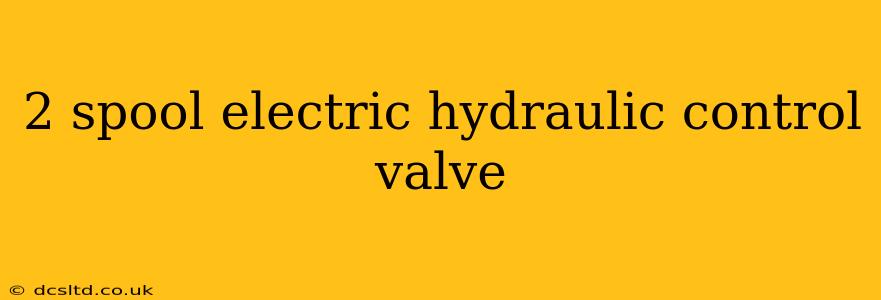Understanding 2 Spool Electric Hydraulic Control Valves
A 2 spool electric hydraulic control valve is a crucial component in many hydraulic systems, offering precise control over the flow of hydraulic fluid. This article delves into the intricacies of these valves, explaining their function, applications, and key considerations for selection and maintenance. We'll also address common questions surrounding these essential pieces of equipment.
What is a 2 Spool Electric Hydraulic Control Valve?
A 2 spool electric hydraulic control valve is a type of directional control valve that uses electrical signals to control the flow of hydraulic fluid through two independent spools. Each spool controls a separate hydraulic circuit, allowing for independent operation of two actuators, such as hydraulic cylinders or motors. The "electric" designation indicates that the valve is actuated by an electrical signal, typically a low-voltage signal, rather than manual levers or pneumatic pressure. This provides for remote operation and integration into automated systems.
How Does a 2 Spool Electric Hydraulic Control Valve Work?
The valve's operation relies on solenoids. When an electrical signal is sent to a specific solenoid, it energizes, moving the corresponding spool within the valve body. This spool shifts, opening or closing passages within the valve, directing hydraulic fluid to the connected actuators. The two spools operate independently, allowing for individual control over each hydraulic circuit. This contrasts with single-spool valves, which only control a single hydraulic circuit.
Types of 2 Spool Electric Hydraulic Control Valves:
Several variations exist, categorized by their spool configurations:
- 2/2-way valves: Each spool controls one flow path, allowing for either flow or no flow.
- 3/2-way valves: Each spool offers three positions: one for forward flow, one for reverse flow, and one neutral (no flow) position. This offers more control and versatility.
- 4/2-way valves: Each spool provides four ports; this configuration often involves a pressure port, a tank port, and two actuator ports, providing more sophisticated flow control.
The selection of a specific type depends on the application's requirements.
Applications of 2 Spool Electric Hydraulic Control Valves:
These valves find applications across diverse industries:
- Construction equipment: Controlling hydraulic cylinders in excavators, loaders, and bulldozers.
- Agricultural machinery: Operating hydraulic implements in tractors and harvesters.
- Manufacturing processes: Automating processes involving hydraulic presses, lifts, and clamping systems.
- Material handling: Controlling the movement of hydraulic lifts and conveyors.
Advantages of Using a 2 Spool Electric Hydraulic Control Valve:
- Precise control: Offers independent and precise control of two hydraulic circuits.
- Remote operation: Allows for remote operation and automation of hydraulic systems.
- Increased safety: Eliminates the need for manual operation, reducing the risk of operator injury.
- Improved efficiency: Optimized for precise control, reducing energy waste associated with uncontrolled flow.
What are the different types of solenoids used in these valves?
Several solenoid types are employed, each with specific characteristics impacting performance and reliability:
- DC solenoids: These use direct current and are often favored for their precise control and responsiveness.
- AC solenoids: Alternating current solenoids may be more robust in harsh environments but can be less precise.
The choice of solenoid type depends on factors like power supply availability and the application's specific requirements.
How do I select the right 2 spool electric hydraulic control valve for my application?
Selecting the appropriate valve hinges on several key considerations:
- Flow rate: The required flow rate of hydraulic fluid.
- Operating pressure: The maximum operating pressure of the system.
- Spool configuration: The required number of positions and flow paths for each spool.
- Voltage: The voltage rating of the solenoids.
- Mounting: The type of mounting required for integration into the hydraulic system.
- Environmental factors: The valve must withstand the specific environmental conditions of its application.
What is the typical maintenance required for a 2 spool electric hydraulic control valve?
Regular maintenance is crucial for optimal performance and longevity. This includes:
- Regular inspection: Checking for leaks, damage, and proper operation.
- Cleaning: Removing debris and contaminants that may impede valve function.
- Lubrication: Applying lubrication to moving parts as needed.
- Solenoid testing: Verifying the proper operation of the solenoids.
Following the manufacturer’s recommendations is essential for effective maintenance.
This comprehensive guide provides a foundational understanding of 2 spool electric hydraulic control valves. By carefully considering the factors discussed, you can select and maintain these critical components for optimal performance within your hydraulic system. Remember to always consult the manufacturer's specifications and safety guidelines before installation and operation.
